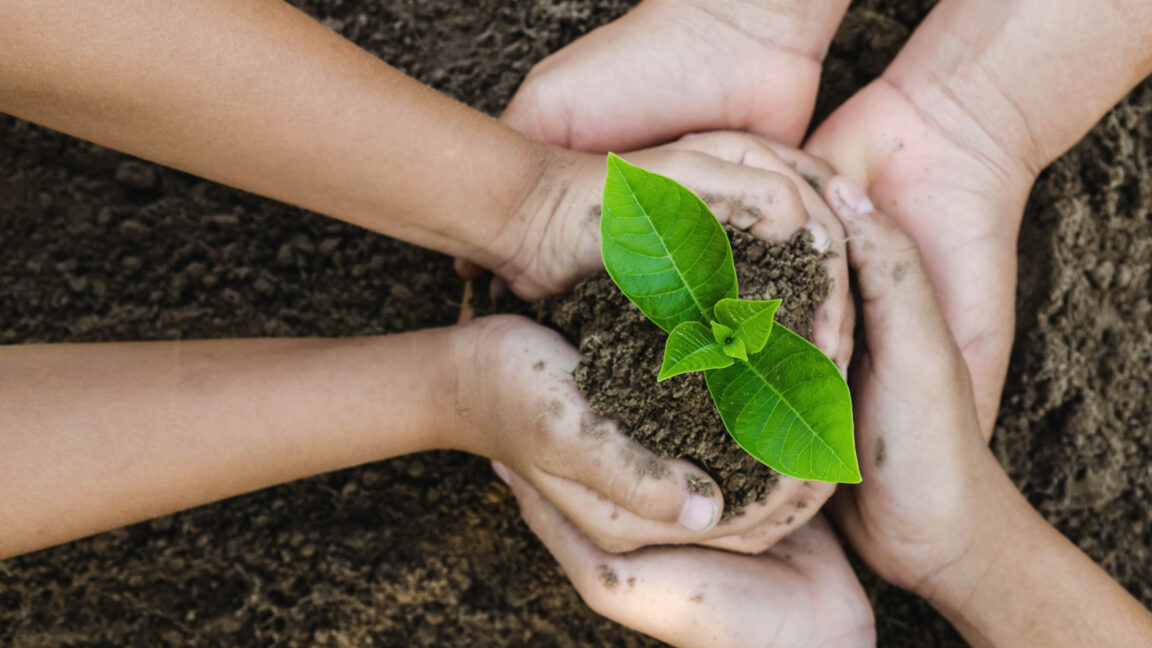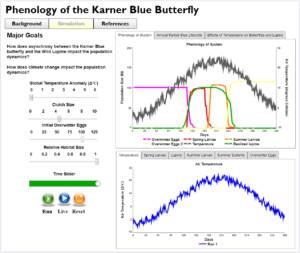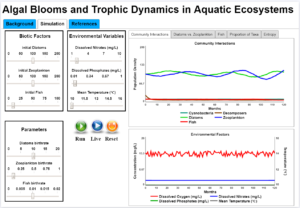Teaching Climate Science and Resilience with Computer Simulations

As my biology class approached the school library recently, one student asked, “Mr. Darkow, do you know of any books about the environment that are not depressing?”
Another student quipped, “Those would be in the fiction section.”
The whole class broke out laughing, me included.
I’ve enjoyed teaching about the environment ever since I started in the classroom 16 years ago, but I didn’t consider myself a climate activist. That slowly changed when letters to the editor from my former students—letters making political arguments based on misconceptions of climate data—began appearing in our local newspaper.
As letter after letter was published, I realized that my curricula weren’t preparing students sufficiently for understanding the origins of scientific data on climate and why these data matter. As a result, I began to restructure my biology courses to focus more intently on how we know what we know about climate change and its effects in the biological world. I’ve learned that teaching climate science to impressionable and innocent adolescents can sometimes feel risky or arduous, but it also presents an exciting challenge for educators to grow their and their students’ understanding of the science and policy of climate change.
Teaching climate science to impressionable and innocent adolescents can sometimes feel risky or arduous, but it also presents an exciting challenge for educators to grow their and their students’ understanding of the science and policy of climate change.
We do, indeed, have powerful and uplifting stories of ecological visionaries and political will, stories where ecosystems have been restored: Rachel Carson and the regulation of pesticides, Joe Farman and the global ban of chlorofluorocarbons, Gregory Carr and the philanthropic restoration of Mozambique’s Gorongosa National Park, and others. We need to share and celebrate these examples of positive work for the greater good.
At the same time, science teachers are in a unique position to minimize climate change’s impact on people, other species, and ecosystems by showing how changes in our current behavior could hold catastrophic climate change at bay (Intergovernmental Panel on Climate Change, Working Group III, 2014). To do so, we first need to build students’ knowledge and skills in understanding the ways we know that our global climates are changing, as well as in understanding the often-stark ways ecosystems have already changed as a result of climate change.
Equally importantly, we need to help students see the exciting, hopeful power that humans hold with respect to environmental and climate issues. Sometimes, that power has been used to degrade ecosystems and our atmosphere, but it’s also the key to stopping climate change.
The way I’ve approached both the problem of addressing large ecosystem impacts from human activities and how students can visualize real, incremental solutions in my classroom is through building computer models that they can use to run simulations. Designing and working with computer simulations allows learners to authentically practice scientific skills woven into the Next Generation Science Standards (NGSS) and Advanced Placement (AP) Biology standards, and the work also lets their thinking parallel the modeling that many scientists do to understand climate change.
Computer models are powerful in climate research for three reasons. First, they let scientists try to understand what parameters are driving changes we’re already seeing in natural systems. Second, while models of all sorts have limitations, they can be extremely useful tools to understand systems that you wouldn’t want to destroy. After all, we can’t run randomized controlled experiments on the emissions threshold needed for runaway global greenhouse gas effects or catastrophic changes to ecosystems. Simulations allow us to probe those ideas in a humane way. Third, computer models allow scientists (and students) to understand possible solutions to environmental changes and to learn what actions can be done to positively affect change to our environment.
Students can see it is possible to have a positive effect on endangered species by intervening in the current conditions.
Sometimes, the connection between climate change and the traditional content of biology class can feel overwhelming. One of the NGSS standards for high school biology is HS-LS2-7: “Design, evaluate, and refine a solution for reducing the impacts of human activities on the environment and biodiversity” (“HS-LS2-7 Ecosystems: Interactions, Energy, and Dynamics,” n.d.). Simulations are a powerful way to allow students to explore and use data from complex, dynamic systems in a more targeted and simpler framework. To help students accomplish the goal of this and other NGSS standards, I built two computer models that allow students to adjust initial conditions and run simulations based on those conditions, giving them opportunities to experiment and explore these complex systems in a manageable way. Both models run online in web browsers and are free to use.
One of the simulations I’ve created gives students the opportunity to test the effects of climate change on the phenology, or life cycle timing, of the Karner blue butterfly (available online at https://sites.google.com/site/biologydarkow/phenology-of-the-endangered-karner-blue-butterfly). This simulation allows students to see how adjusting the mean global temperature affects the emergence of the Karner blue butterfly, an endangered butterfly found throughout the Northeast and northern Midwest. Students run the simulation in order to record how a population of eggs, larva, and butterflies change over the course of a year. Students can adjust the temperature, clutch size, the number of eggs, and the habitat size. Students then can run simulations in which they adjust these initial conditions (see Figure 1).

Figure 1. Interface of the Karner blue butterfly simulation, a web-based tool available free to teachers and students at https://sites.google.com/site/biologydarkow/phenology-of-the-endangered-karner-blue-butterfly.
In the simulation, an increase in temperature causes the larva to emerge earlier in the springtime. However, their food source (the wild lupine) does not shift at the same rate. This results in the caterpillars emerging without their food source. This asynchrony caused by a changing climate is having an effect on the butterfly populations in the real world, as the animals are starving without their food source. Students can see that increasing habitat size, increasing food source, and minimizing the mean global temperature all can positively affect the butterfly population and reduce the impacts of climate change on the Karner blue. This allows students to see that it is possible to have a positive effect on endangered species by intervening in the current conditions. For example, students might decide to cultivate native plant butterfly gardens at home or in green spaces to increase the size of the butterfly habitat in their communities, or call on their representatives to enact policies that seriously mitigate their communities’ carbon footprints.
Another computer model that I have my students use to explore how humans are affecting ecosystems is called “Algal Blooms and Trophic Dynamics in Aquatic Ecosystems” (available online at https://sites.google.com/site/biologydarkow/ecology/catastrophic-regime-change-in-aquatic-ecosystemshttps://sites.google.com/site/biologydarkow/ecology/catastrophic-regimechange-in-aquatic-ecosystems). Using this model, my students investigate how different biotic factors, environmental variables, and population parameters affect the community interactions in a freshwater ecosystem like Lake Erie. The simulation runs show how diatoms (a type of green algae), zooplankton, fish, cyanobacteria (blue-green algae), and decomposers can change over time in response to environmental conditions (See Figure 2).

Figure 2. Interface of the algal blooms simulation, a web-based tool available free to teachers and students at https://sites.google.com/site/biologydarkow/ecology/catastrophic-regime-change-in-aquatic-ecosystems.
NGSS standard HS-LS2-6 asks students to “Evaluate claims, evidence, and reasoning that the complex interactions in ecosystems maintain relatively consistent numbers and types of organisms in stable conditions, but changing conditions may result in a new ecosystem” (“HS-LS2-6 Ecosystems: interactions, Energy, and Dynamics,” n.d.). By running the aquatic ecosystem simulation, students discover that increases in both nitrates and average temperature do not have a large effect on the ecosystem, but the system is less resilient to increases in phosphates. They also notice that temperatures above a certain threshold cause the ecosystem to change from a diverse ecosystem to an ecosystem comprised mostly of cyanobacteria and decomposers. Just as in this simulation, there are thresholds in all our real-world ecosystems, and once those thresholds are passed, catastrophic changes can result.
Here is where resilience emerges powerfully from this work. Students can see that minimizing the number of nitrates and phosphates can positively affect the biodiversity and relative concentrations of abiotic factors in the aquatic ecosystem. Students can also see that small increases in the mean temperature won’t cause the ecosystem to collapse, but more dramatic increases can. In my classroom, students use simulation data to build an argument that we can conserve the biodiversity of aquatic ecosystems by minimizing temperature, nitrates, and/or phosphates. I’ve not yet found a more powerful way for students to see that people (including themselves) can be agents of positive change for environmental resilience.
Every year on the National AP Biology Teachers Facebook group, teachers from around the country claim that they will be having students learn ecology over the summer via a summer assignment. This is a mistake. The catastrophic effects to our ecosystems should not be taught as a summer assignment. When teachers deprioritize ecology, they communicate to students that our interdependence with our environment is trivial.
We are living during a human-centered time, the Anthropocene. Our ability to address climate change and widespread biodiversity loss will require people taking these issues seriously. Therefore, one of the most important gifts a biology teacher can give their students is the understanding that humans live interdependently with their ecosystems. Concepts like feedback loops, thresholds, and interdependent behaviors are not intuitive, but with a great deal of support and scaffolding, students will learn that by leveraging Earth’s systems (e.g., habitat size, mean temperature, and the number of nutrients in our lakes), humans can mitigate damaging ecosystem changes. Our students—and our future—deserve our best science teaching.
Citation
Darkow, J. (2020). Teaching climate science and resilience with computer simulations. Kaleidoscope: Educator Voices and Perspectives, 6(2), 6–10.
